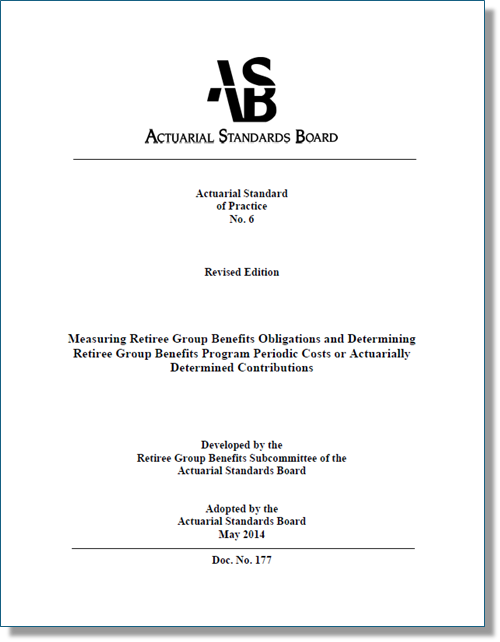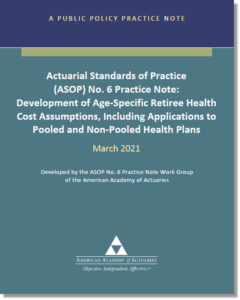The need for age-specific costs and implicit subsidies in retiree health valuations
Introduction – The Reality of Aging
| Age | Per-Capita Cost/Year |
| 45-49 | $7,000 |
| 50-54 | $10,000 |
| 55-59 | $13,000 |
| 60-64 | $15,000 |
For the average person covered by a medical or prescription drug plan, the cost of providing that benefit will increase as they age since their health conditions become more numerous and acute, requiring more frequent provider visits for increasingly specialized care and pricier medications. Looking at average annual costs with five-year age brackets, a person might see their annual medical costs rise with age as shown in the table at left (before Medicare finally brings some relief with an offset to costs starting at age 65). The big question for actuaries of the past was when do they need to recognize this reality in their valuation work?
The Push to Recognize Age-Specific Costs in Retiree Health Valuations
In years past it was common for an actuary to perform a retiree health valuation assuming one initial per-capita cost as averaged over all ages prior to 65, so that in the example above they might apply an average cost of $12,000 to every age from 45 to 64. If coverage extended past age 64, then it was likewise common to assume one other per-capita cost as averaged over all ages 65+.

Health actuaries are under constant pressure to minimize the cost of their valuations, so it should come as no surprise that there was resistance when Actuarial Standards of Practice No. 6 (ASOP No. 6, “Measuring Retiree Group Benefits Obligations and Determining Retiree Group Benefits Plan Costs or Contributions”) was introduced in 1988 with the mild suggestion that actuaries should consider making their valuation per-capita costs be age-specific. After years of debate, the first revision of ASOP No. 6 was released in 2001 with a strengthened admonition, then a second revision in 2014 (pictured at left) settled the matter by declaring outright that health actuaries must age-rate costs except in a few very limited circumstances, otherwise they’ll be in violation of an ASOP. Such a violation could lead to a review by the Actuarial Board for Counseling and Discipline (ABCD), and in extreme cases the loss of actuarial credentials.
Reflection of any Implicit Subsidy
The new rule to age-rate costs had immediate implications for situations where a health plan covers a mix of actives and retirees. In the example below, an insurance company covers a group consisting of two-third active employees (with a low average annual per-capita cost of $9,000) plus one-third non-Medicare retirees (with a relatively high average annual per-capita cost of $12,000), and they charge everyone a mixed premium equal to [$9,000 x 2/3] + [$12,000 x 1/3] = $10,000. Prior to the adoption of the revised ASOP No. 6, an actuary could just use the $10,000 premium as their initial per-capita cost, then apply trend to that for their valuation projections. Now, they are required to estimate the retiree-only age-specific per-capita costs (as in column [D] below), and then reflect the excess of those costs over the mixed active/retiree premium as the “implicit subsidy of the retirees by the actives.” As shown below in column [E], that implicit subsidy can end up positive or negative at different ages, but overall it will generally increase the plan sponsor’s liability as calculated for the valuation. This is true even if the retirees are required to self-pay 100% of the premium in order to get coverage, in which case the plan sponsor’s only retiree health liability would be for the implicit subsidy.
Age |
[A] Premium = Active/Retiree Average Per-Capita Cost |
[B] Active Average Per-Capita Cost |
[C] Retiree Average Per-Capita Cost |
[D] Retiree Age-Specific Per-Capita Cost |
[E] Implicit Subsidy = [D] – [A] = Excess of Retiree Age-Specific Per-Capita Cost over Premium |
| 45-49 | $ 10,000 | $ 9,000 | $ 12,000 | $ 7,000 | $ (3,000) |
| 50-54 | 10,000 | 9,000 | 12,000 | 10,000 | 0 |
| 55-59 | 10,000 | 9,000 | 12,000 | 13,000 | 3,000 |
| 60-64 | 10,000 | 9,000 | 12,000 | 15,000 | 5,000 |
Guidance on How to Comply with the New Rules on Age-Specific Costs & Implicit Subsidies
 Among the objections voiced to the new rule in ASOP No. 6 was that there were no specific examples provided of how an actuary can divine a health plan’s hidden underlying age-specific costs, and that any method would require very granular health data which is exceedingly difficult to obtain. These concerns were finally addressed with guidance from the American Academy of Actuaries in the form of a 2021 ASOP No. 6 Practice Note (pictured at left) as authored by the top practitioners in the field including Rael & Letson’s Jim Whelpley. This note provided pragmatic advice on how to calculate age-specific costs and implicit subsidies, including an embedded worksheet with example formulas. It also made clear that a lack of data wasn’t an excuse to avoid age-rating, instead it just meant that the actuary has to make some assumptions and draw upon publicly-available sources.
Among the objections voiced to the new rule in ASOP No. 6 was that there were no specific examples provided of how an actuary can divine a health plan’s hidden underlying age-specific costs, and that any method would require very granular health data which is exceedingly difficult to obtain. These concerns were finally addressed with guidance from the American Academy of Actuaries in the form of a 2021 ASOP No. 6 Practice Note (pictured at left) as authored by the top practitioners in the field including Rael & Letson’s Jim Whelpley. This note provided pragmatic advice on how to calculate age-specific costs and implicit subsidies, including an embedded worksheet with example formulas. It also made clear that a lack of data wasn’t an excuse to avoid age-rating, instead it just meant that the actuary has to make some assumptions and draw upon publicly-available sources.
Exceptions to the Rule – When an Actuary Doesn’t Need to Develop Age-Specific Costs
ASOP No. 6 provides two main exceptions to the general rule of age-rating health costs:
- The measurement period is short enough so that aging won’t have much of an effect
(like for a closed retiree group where all coverage ends in a few years).
- Costs do not vary significantly by age for the type of benefit plan being valued
(as for Medicare Advantage plans, or medical plans with a low annual benefit limit).
The current version of ASOP No. 6 also includes an exception for when a plan’s mixed active/retiree premium is “sustainable” over the measurement period, but the ABCD has said that any actuary claiming this exception would have to prove it numerically, thus making it essentially unusable. That exception is therefore due to be excluded from the third revision to ASOP No. 6 that’s now underway.
It’s therefore true that, except in very limited cases, an actuary performing a retiree health valuation must take the time to research and develop age-specific per-capita costs, and must include a liability for any implicit subsidy of the retirees by the actives. Doing so provides a more accurate picture of the plan sponsor’s long-term financial situation and leads to better decisions in response.
Have questions or want to learn more? Contact us.

You must be logged in to post a comment.